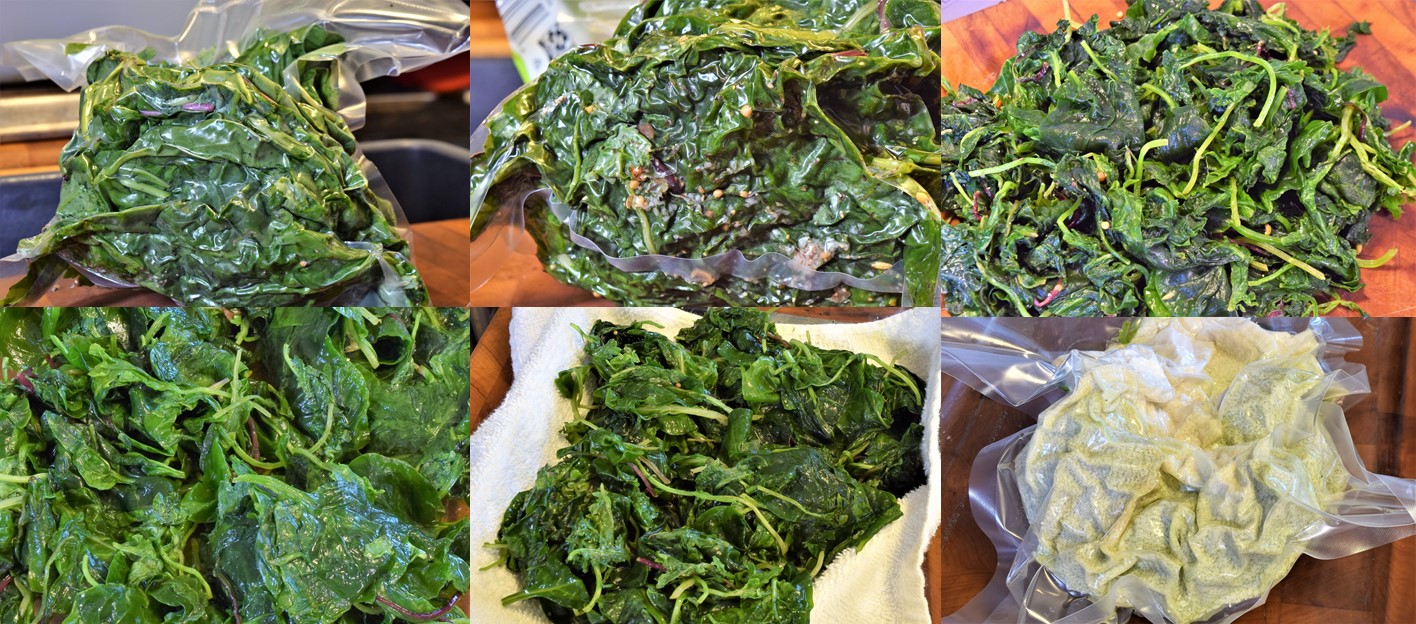Procedure:
Place the greens into a large bowl or sheet pan. Sprinkle very lightly with S+P. Wait a few minutes, and the greens will just start to shrink down.
Do not add any form of acid. Lemon juice or vinegar will darken and dissolve the greens. Load greens as tightly as possible into a vacuum bag, and remove the air. This will also work in a FoodSaver type device, and even in a Ziploc freezer bag. Some air will remain in the Ziploc. Make sure you pack the greens as tightly as possible. After only a few minutes, you will see a moist appearance to the contents of the bag. This effect will continue. Store the bag in the refrigerator over night @
40F/4C.
Yyou will see a lot of moisture in the bag, as a result of the curing process. Remove the greens and drain. If you are using Ziploc bags, just squeeze as much juice as possible out of the greens before moving on to the next step. Load the greens into a clean kitchen towel, wrap up tightly, and vacuum seal again. Wait at least one hour, or store overnight in the refrigerator.
This process is the best way to preserve the bright green color of all leafy vegetables. Cooking always darkens greens, and this is one of the characteristics that discourage diners and chefs. The curing process limits this effect, even during subsequent heating. Remove the greens from the towel, and they are now ready to use or store.
Applications
These make a nice “bruised” salad that we implement in our recipe for Golden Beets:
There are many possible applications, but creamed spinach is still the most popular incarnation of fresh greens. It appears regularly on side dish lists offered in high priced steak houses. Sadly, it is almost always prepared with frozen/defrosted spinach.
No dish could be simpler. Make one batch of Béchamel linked HERE, and add the cold greens to the hot sauce.
In restaurants that offer creamed spinach, you may notice wording that carefully avoids describing the creamed spinach as being “fresh,” unlike the asparagus and broccoli, etc. I suspect the reason for this is the fear of the blackening effect that accompanies boiling greens as if they were carrots, etc., and the lack of knowledge of this curing process.
Attempting to quickly saute fresh spinach/kale in a pan (they are closely related) typically results in darkening and the release of a lot of water. Even if well drained, the spinach/kale will continue to darken unless served immediately. This is almost never convenient, in the restaurant or in the home.
For a finer creamed greens, pulse the cold vegetable in a food processor before adding the béchamel. Do not overmix the sauce in the food processor–too much friction will break the sauce.
It takes very little béchamel to make this version of the creamy greens. For every 10 oz./300g of well drained kale, no more than 1/2 cup/120ml of sauce is needed.
In dishes that use the creamed greens either below or inside, use the cured leaves as a reminiscent garnish. Below is our version of stuffed salmon glacage.
Creamy greens make an excellent accompaniment to hearty dishes, like the hanger steak roulade below, with mille feuille potatoes and creamed corn.
If well preserved, the green accent adds a nice colorful counterpoint to the darker colors of the beef and the potatoes.
with sauce Foyot and balsamic syrup.Watch for upcoming recipes incorporating this delicious and healthy vegetable!
Norm









